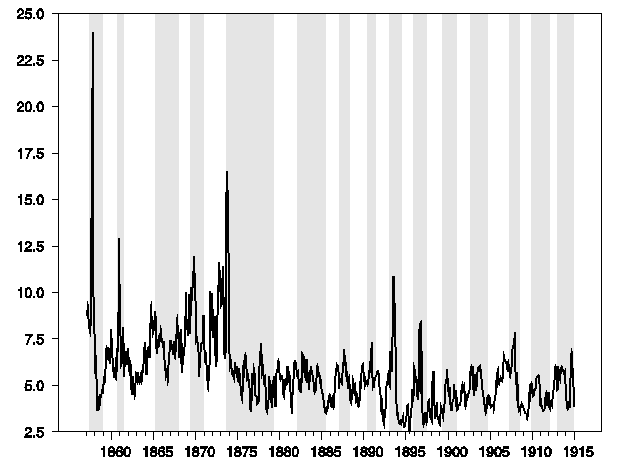Tyler Cowen acknowledges that the gold standard as implemented in 1929-1932 was a disaster, and that a gold standard would also work very poorly in the presence of the big changes in the real value of gold over the last decade. But in the interests of promoting a balanced discussion, he asks:
Dare anyone critical of the gold standard bring themselves to utter these (roughly true) words?: “For the Western world, the gold standard era, defined say as 1815-1913, was arguably the greatest period of human advance ever, at least in matters of economics, culture, and technology.”
Here are my thoughts on Tyler’s question.
There was indeed spectacular real economic growth in the nineteenth and early twentieth centuries. But it is unnatural to me to suggest that the monetary standard was the key cause of this. Instead I would point to real developments. For example, U.S. production of crude petroleum quadrupled between 1868 and 1878 and doubled every decade after that up through 1915, thanks primarily to discovery of huge new fields as the industry expanded geographically (see Hamilton (2012)). By 1890, the U.S. had laid 200,000 miles of rail track, and that too was to double again by 1917 (see Historical Statistics of the United States, Table Df927-955). Discovery of the steam engine, electricity, and machine tools were surely more important than monetary policy in determining the real growth rate for over a century.
The question should not be whether long-term growth occurred under the nineteenth-century gold standard, but instead whether the monetary system contributed to cyclical instability over that period. It is hard to make the case that it was helpful. The graph below plots short-term U.S. interest rates over the period 1857-1915. With some regularity, the cost of borrowing would spike up in dramatic financial events, as it did for example in the panics of 1857, 1873, 1893, 1896, and 1907.

The NBER’s business cycle dates also characterize this era as experiencing economic recessions more frequently and of longer duration than observed since the U.S. abandoned the gold standard in 1933, with recessions usually following the financial panics.

It is true that the biggest concern I have about going back on a gold standard today– that it would tie the monetary unit of account to an object whose real value can be quite volatile– was not the core problem associated with the system of the 19th century.
But the fact that this wasn’t the core problem with the gold standard in the nineteenth century does not mean that it wouldn’t be a big problem if we tried to go back to the system in the twenty-first century.
On the other hand, if you figure out some way to double U.S. oil production every decade for the next 40 years, I expect you’d see another golden era of economic growth, regardless of the monetary policy followed by the United States.
- Bulenox: Get 45% to 91% OFF ... Use Discount Code: UNO
- Risk Our Money Not Yours | Get 50% to 90% OFF ... Use Discount Code: MMBVBKSM
Disclaimer: This page contains affiliate links. If you choose to make a purchase after clicking a link, we may receive a commission at no additional cost to you. Thank you for your support!



Leave a Reply